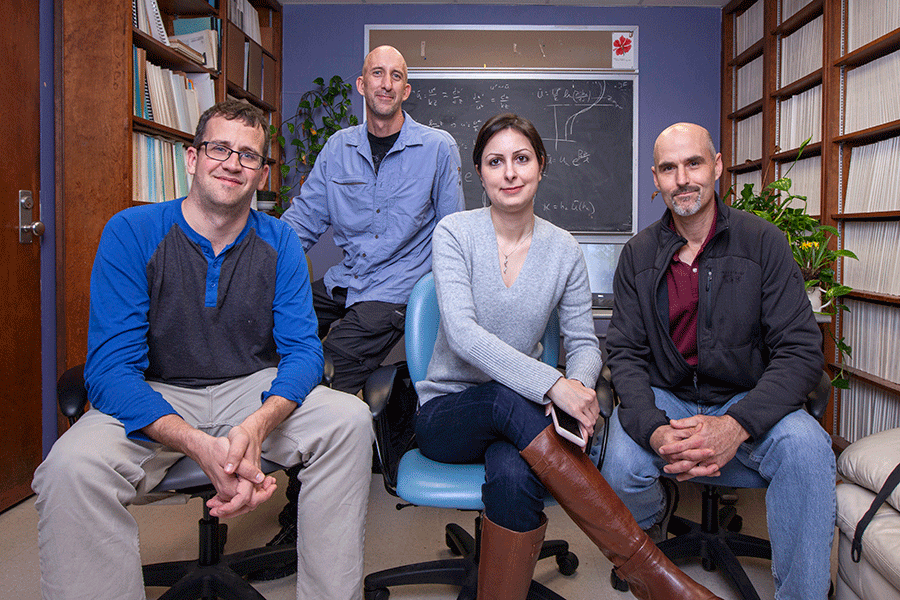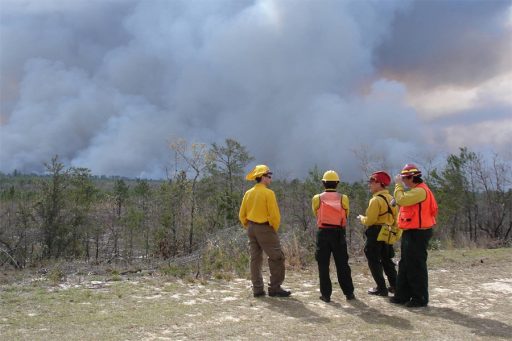
In the effort to mitigate destructive wildfires, wildland managers often fight those uncontrolled fires with prescribed fire — carefully controlled burns to safely eliminate the vegetation that piles up on forest floors and adds to potential fuel.
Prescribed fires are an important tool for managing fire-prone landscapes, but they come with a cost. Fire makes smoke, which carries tiny, unburnt particles through the air, lowering air quality and making breathing more difficult.
A $2.2 million Department of Defense grant will fund an FSU investigation into the dynamics of smoke from prescribed burns, giving land managers a better understanding of when and how to best use the technique.
“When we understand how plumes are affected by key controls, such as the ignition pattern, this is one way that fire managers will be able to engineer plumes that have a less significant impact on communities,” said Assistant Professor of Scientific Computing Bryan Quaife.
Understanding how smoke plumes develop and travel is an interdisciplinary problem. FSU researchers from the Department of Scientific Computing, the FAMU-FSU College of Engineering’s Department of Mechanical Engineering and the Geophysical Fluid Dynamics Institute are partnering with the forest research station Tall Timbers, Los Alamos National Laboratory and others to understand the complexities of wildland fires.
Partnering with investigators who have fire management experience helps researchers take what they discover at an academic level and transition it to a practical application. Existing knowledge about how fires burn informs their model. They refine that with new parameters, such as the topography and distribution of vegetation that acts as fuel in a burn plot, the way wind moves through the plot, the fuel moisture and the heat radiated from the fire — then collect data from an actual fire to make a more accurate model of how smoke plumes rise from a prescribed burn.
“We want our models to capture the true physics and our simulations to be as close to what really happens in the field as possible,” said Neda Yaghoobian, an assistant professor of mechanical engineering at the FAMU-FSU College of Engineering. “This requires parameters that can take input from fire managers and other researchers to refine our model.”
Fire managers using prescribed burning must balance competing interests when they decide when and where to use the tool. Smoke from fires lowers air quality. When a prescribed fire burns, managers must sometimes field complaints from people downwind, and they must be careful to ensure that smoke plumes don’t carry embers that can create undesired spot fires.

But these deliberately set fires have benefits, including making uncontrolled wildfires less likely and removing invasive species. A small prescribed fire that creates little smoke is less likely to bother nearby residents, but it leaves a plot with a greater risk of wildfire in the future.
As more people live closer to woodlands, the stakes for controlling fires rise, and it becomes more challenging for fire managers to find a window to run a prescribed burn, Quaife said.
Many aspects of the procedure are out of the control of land managers, but one thing they can control is how they light the fire. For example, they can light a fire in a long line, or they can create several spot fires that burn toward each other. Researchers will examine how the different patterns of burning affect the smoke plume that is created, giving land managers a better understanding of where smoke might go.
One of the big challenges for this research is that a lot of the physics happens at very small scales. Researchers may be interested in how fire moves around a tree that is only a few inches across in a much larger plot of land. Multiply that by the many parameters they track, and the task becomes very complex. The most advanced fire simulations run on thousands of computer processors for several hours to predict a few minutes of a fire’s behavior.
“From an operational point of view, that doesn’t make sense,” Quaife said. “Part of the work we are doing is hopefully to be able to not only develop better models but also to develop simplified models that can run in more of an operational setting, rather than something that requires a supercomputer. Obviously, when you’re a prescribed fire manager, you cannot remotely log into the Los Alamos supercomputer to run a simulation and wait around for a half hour to figure out what’s going to happen in the next 30 seconds.”
Kevin Speer, director of the Geophysical Fluid Dynamics Institute at FSU, is contributing to this research.
"mechanical" - Google News
December 13, 2019 at 02:18AM
https://ift.tt/2EaUXXZ
FSU researchers use mechanical engineering, scientific computing and forestry to better understand prescribed burns - Florida State News
"mechanical" - Google News
https://ift.tt/36eZe8V
Shoes Man Tutorial
Pos News Update
Meme Update
Korean Entertainment News
Japan News Update
0 Comments:
Post a Comment